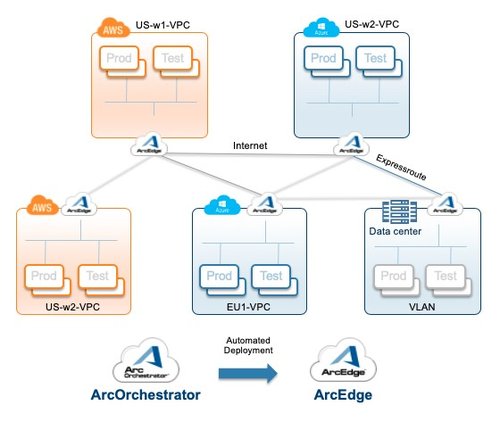Accelerating Application Utilization with a New Paradigm in Multi-Cloud Networking
July 21, 2020 | Sreekanth Kannan
The era of application workloads deployed and consumed from enterprise data centers and the public cloud are exploding across our digital-first world. As these mid-to-large sized organizations rapidly expand to deploy their workloads either as monoliths or microservices, in virtual machines, in containers or as a hybrid – within their own data centers or in the public cloud, the need for a new networking architecture and solution is now critical.
The team at Arrcus has been fortunate to engage in deep dive interaction with many professionals from different industry verticals – technology, financial services, retail and with diverse functional responsibilities – networking architects with CCIEs, DevOps engineers managing large cloud infrastructure and site reliability pros managing large SaaS deployments. A week in the life of these professionals usually means working across multiple data centers with interconnects to Amazon AWS, Microsoft Azure and/or other cloud providers, many cloud accounts and 100’s to 1000’s of VPCs with numerous compute nodes serving workloads impacting millions and sometimes billions of active users. Universally and unambiguously, all the professionals shared that the current multi-cloud networking architecture based on the legacy on-prem routers is just not working. Problems with this legacy cloud router design results in:
- No integration between existing data center IP clos network and the cloud infrastructure leading to massive performance and scale issues
- High data center or ISP co-location reliance for multi-region cloud connectivity. This includes deploying multiple private circuits with link aggregation groups (LAG, LACP) and statically configured Q-in-Q
- Rigid hub-spoke deployment for all nodes resulting in traffic hair pinning through data center and resulting in periodic and expensive WAN router upgrades
- Lack of end-to-end security especially strong encryption like AES-256 for all traffic and for all transport links including Internet
- Different tool chains, workflows and operating model. Unfortunately executing a network change control results in modifying many device configurations, weeks of planning and high likelihood for human errors
- Lack of visibility and abstraction fatigue. Operators desist just yet another ‘console’ from managed solutions that reduces the network visibility and observability needed to monitor, troubleshoot and ensure high uptime – also creating unnecessary lock-in
Besides this long list of functional deficiencies, the teams are simultaneously contending with a set of requirements that needs a completely new networking paradigm. Few of the requirements driving the needs are:
- Public cloud providers now are deploying on-prem solutions like Amazon AWS Outposts, Azure Arc, and Google Anthos, driving the need for networks that can support the distributed edge
- Organizations need a single, integrated network to manage networking costs, optimal application utilization, and security. This needs to be engineered by achieving the integration of “overlay” networking and “underlay” networking
- Networking specialists (CCIEs), DevOps, cloud architects and security teams are converging in many key dimensions. Budgets and responsibilities are overlapping, and the operating models should unify the IT professionals responsible for their corresponding functions
One of the prospects shared this visual as a way to represent the tyranny of rigid hub-spoke network design and the transport based multi-cloud network architecture

New paradigm in multi-cloud networking
Arrcus, the hyperscale networking software company, announced multi-cloud networking (MCN) platform to enable highly available connectivity for workloads and data across any cloud, any region and any site. The Arrcus MCN platform consists of ArcEdge, which is a secure data plane element and ArcOrchestrator, which is the modern orchestrator that dramatically simplifies connectivity with cloud-native security, and hyperscale performance.

Enterprises can now confidently deploy workloads with a tight integration between their data center IP Clos network and the public cloud with a flexible deployment architecture of hub-spoke, full-mesh or hybrid. Operationally efficient with support for common frameworks like Hashicorp Terraform, Ansible playbooks, Open config YANG models and RestAPI.
Hyperscale economics means faster growth
In summary, our customer engagements have enthusiastically embraced the compelling metrics and benefits of Arrcus MCN platform. As an example, a typical deployment with 500 VPCS in Amazon AWS or Microsoft Azure interconnected with data centers via direct connect or expressroute, the Arrcus MCN solution demonstrated at least 2x the performance of the legacy cloud router at 10x the scale measured as total routes supported per VPC, resulting in at least $2 million in annual savings. With a flexible consumption model, scalable solution, unified orchestration, and a low total cost of ownership, the Arrcus MCN solution is ushering a new era in multi-cloud networking.
Learn more about Arrcus MCN
Check us out at\xa0https://www.arrcus.com/solutions/multi-cloud-networking/ or schedule a live demo here: https://www.arrcus.com/demos/arrcus-mcn/.
MCN
Categories
5G
ACE
AI
ArcEdge
ArcIQ
ARCOS
ARRCUS
CLOUD
datacenters
edge
FlexAlgo
hybrid
Internet
INVESTING
IPV4
IPV6
MCN
ML
multicloud
Multicloud
MUP
NETWORKING
NETWORKING INDUSTRY
Routing
SRV6
uSID